key MAZDA MODEL MX-5 MIATA 2006 Owners Manual
[x] Cancel search | Manufacturer: MAZDA, Model Year: 2006, Model line: MODEL MX-5 MIATA, Model: MAZDA MODEL MX-5 MIATA 2006Pages: 378, PDF Size: 4.01 MB
Page 11 of 378
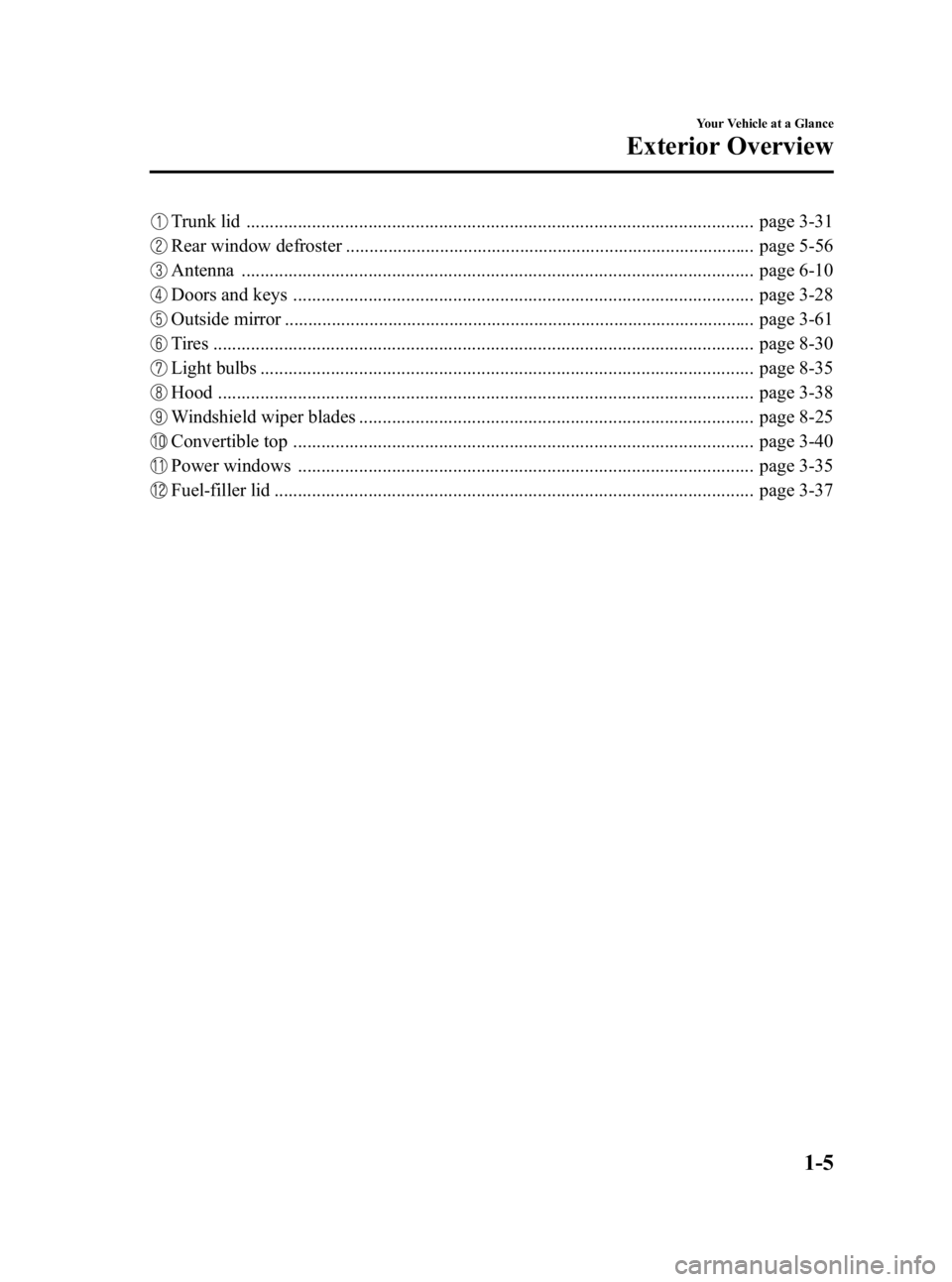
Black plate (11,1)
Trunk lid ............................................................................................................ page 3-31
Rear window defroster ....................................................................................... page 5-56
Antenna ............................................................................................................. page 6-10
Doors and keys .................................................................................................. page 3-28
Outside mirror .................................................................................................... page 3-61
Tires ................................................................................................................... page 8-30
Light bulbs ......................................................................................................... page 8-35
Hood .................................................................................................................. page 3-38
Windshield wiper blades .................................................................................... page 8-25
Convertible top .................................................................................................. page 3-40
Power windows ................................................................................................. page 3-35
Fuel-filler lid ...................................................................................................... page 3-37
Your Vehicle at a Glance
Exterior Overview
1-5
MX-5_8U35-EA-05F_Edition4 Page11
Thursday, October 6 2005 11:2 AM
Form No.8U35-EA-05F
Page 28 of 378
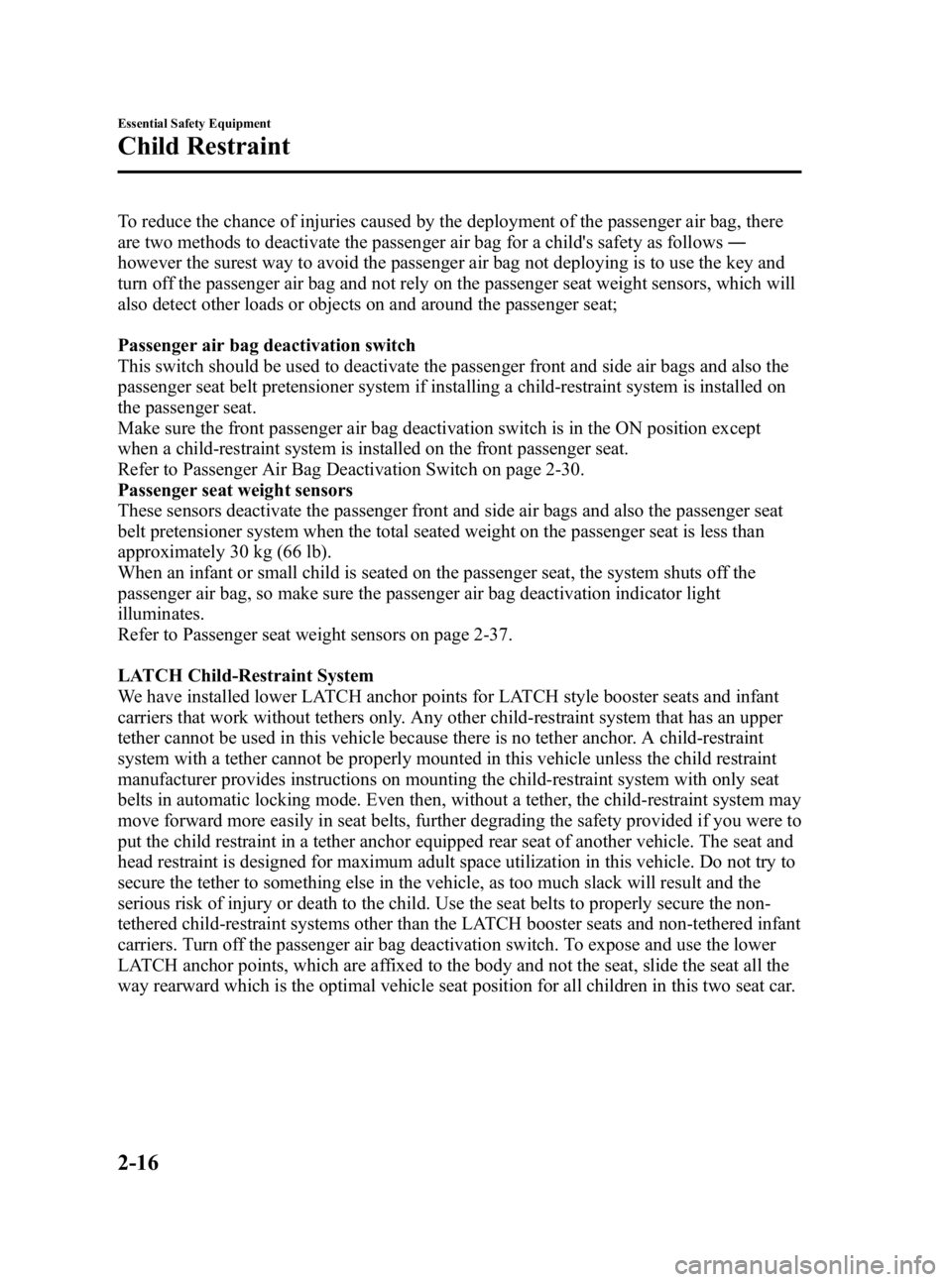
Black plate (28,1)
To reduce the chance of injuries caused by the deployment of the passenger air bag, there
are two methods to deactivate the passenger air bag for a child's safety as follows―
however the surest way to avoid the passenger air bag not deploying is to use the key and
turn off the passenger air bag and not rely on the passenger seat weight sensors, which will
also detect other loads or objects on and around the passenger seat;
Passenger air bag deactivation switch
This switch should be used to deactivate the passenger front and side air bags and also the
passenger seat belt pretensioner system if installing a child-restraint system is installed on
the passenger seat.
Make sure the front passenger air bag deactivation switch is in the ON position except
when a child-restraint system is installed on the front passenger seat.
Refer to Passenger Air Bag Deactivation Switch on page 2-30.
Passenger seat weight sensors
These sensors deactivate the passenger front and side air bags and also the passenger seat
belt pretensioner system when the total seated weight on the passenger seat is less than
approximately 30 kg (66 lb).
When an infant or small child is seated on the passenger seat, the system shuts off the
passenger air bag, so make sure the passenger air bag deactivation indicator light
illuminates.
Refer to Passenger seat weight sensors on page 2-37.
LATCH Child-Restraint System
We have installed lower LATCH anchor points for LATCH style booster seats and infant
carriers that work without tethers only. Any other child-restraint system that has an upper
tether cannot be used in this vehicle because there is no tether anchor. A child-restraint
system with a tether cannot be properly mounted in this vehicle unless the child restraint
manufacturer provides instructions on mounting the child-restraint system with only seat
belts in automatic locking mode. Even then, without a tether, the child-restraint system may
move forward more easily in seat belts, further degrading the safety provided if you were to
put the child restraint in a tether anchor equipped rear seat of another vehicle. The seat and
head restraint is designed for maximum adult space utilization in this vehicle. Do not try to
secure the tether to something else in the vehicle, as too much slack will result and the
serious risk of injury or death to the child. Use the seat belts to properly secure the non-
tethered child-restraint systems other than the LATCH booster seats and non-tethered infant
carriers. Turn off the passenger air bag deactivation switch. To expose and use the lower
LATCH anchor points, which are affixed to the body and not the seat, slide the seat all the
way rearward which is the optimal vehicle seat position for all children in this two seat car.
2-16
Essential Safety Equipment
Child Restraint
MX-5_8U35-EA-05F_Edition4 Page28
Thursday, October 6 2005 11:2 AM
Form No.8U35-EA-05F
Page 29 of 378
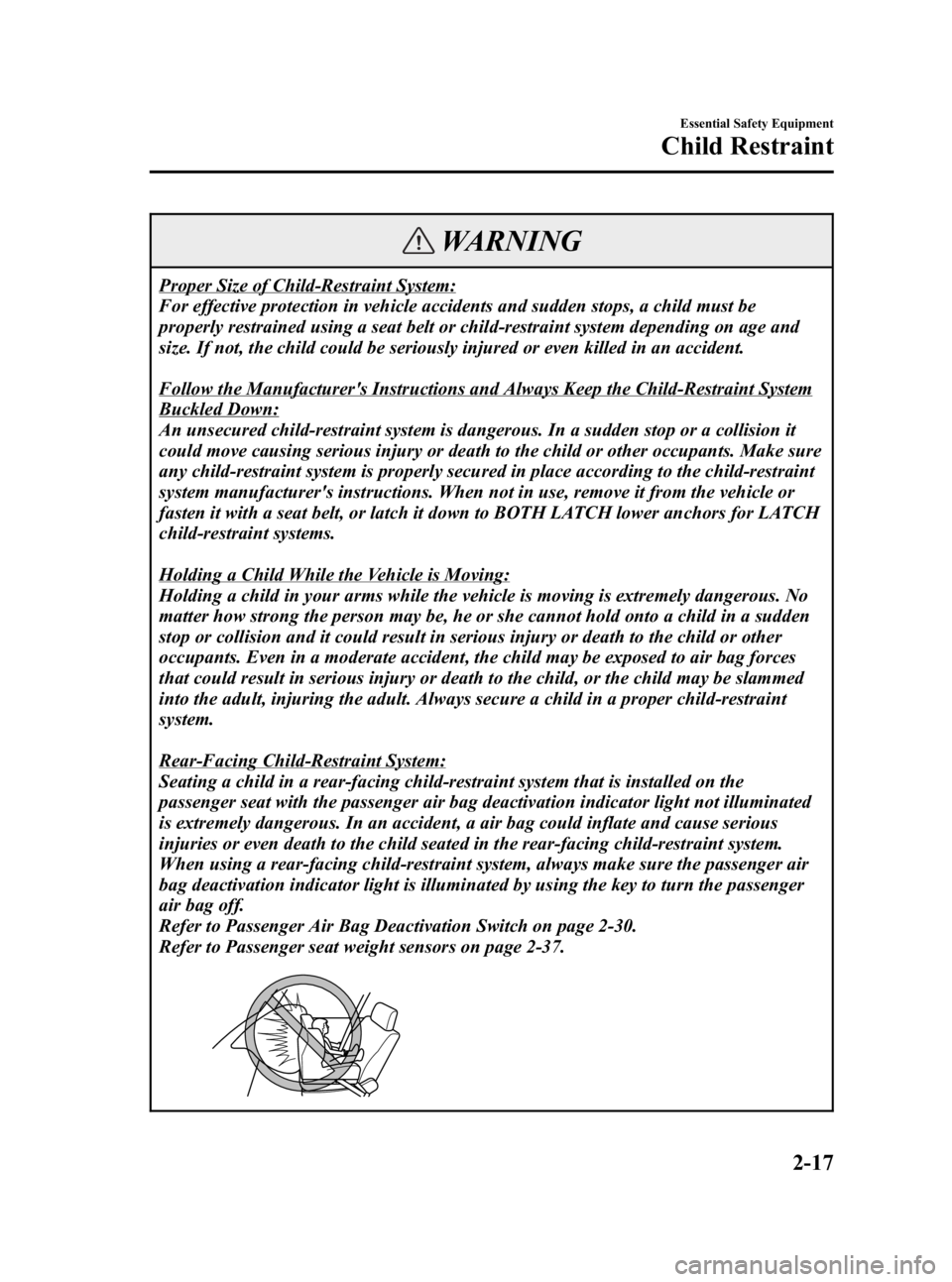
Black plate (29,1)
WARNING
Proper Size of Child-Restraint System:
For effective protection in vehicle accidents and sudden stops, a child must be
properly restrained using a seat belt or child-restraint system depending on age and
size. If not, the child could be seriously injured or even killed in an accident.
Follow the Manufacturer's Instructions and Always Keep the Child-Restraint System
Buckled Down:
An unsecured child-restraint system is dangerous. In a sudden stop or a collision it
could move causing serious injury or death to the child or other occupants. Make sure
any child-restraint system is properly secured in place according to the child-restraint
system manufacturer's instructions. When not in use, remove it from the vehicle or
fasten it with a seat belt, or latch it down to BOTH LATCH lower anchors for LATCH
child-restraint systems.
Holding a Child While the Vehicle is Moving:
Holding a child in your arms while the vehicle is moving is extremely dangerous. No
matter how strong the person may be, he or she cannot hold onto a child in a sudden
stop or collision and it could result in serious injury or death to the child or other
occupants. Even in a moderate accident, the child may be exposed to air bag forces
that could result in serious injury or death to the child, or the child may be slammed
into the adult, injuring the adult. Always secure a child in a proper child-restraint
system.
Rear-Facing Child-Restraint System:
Seating a child in a rear-facing child-restraint system that is installed on the
passenger seat with the passenger air bag deactivation indicator light not illuminated
is extremely dangerous. In an accident, a air bag could inflate and cause serious
injuries or even death to the child seated in the rear-facing child-restraint system.
When using a rear-facing child-restraint system, always make sure the passenger air
bag deactivation indicator light is illuminated by using the key to turn the passenger
air bag off.
Refer to Passenger Air Bag Deactivation Switch on page 2-30.
Refer to Passenger seat weight sensors on page 2-37.
Essential Safety Equipment
Child Restraint
2-17
MX-5_8U35-EA-05F_Edition4 Page29
Thursday, October 6 2005 11:2 AM
Form No.8U35-EA-05F
Page 30 of 378
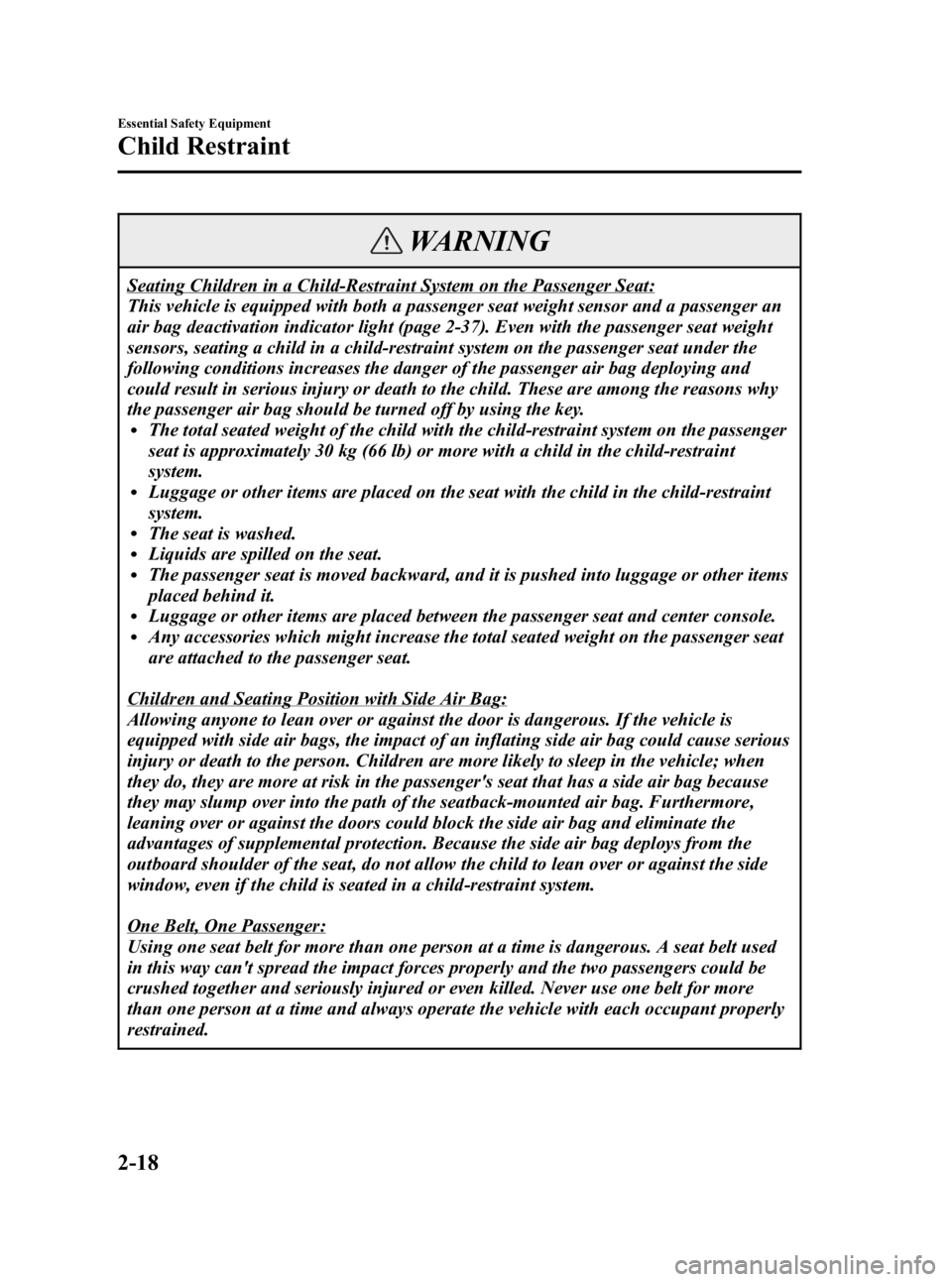
Black plate (30,1)
WARNING
Seating Children in a Child-Restraint System on the Passenger Seat:
This vehicle is equipped with both a passenger seat weight sensor and a passenger an
air bag deactivation indicator light (page 2-37). Even with the passenger seat weight
sensors, seating a child in a child-restraint system on the passenger seat under the
following conditions increases the danger of the passenger air bag deploying and
could result in serious injury or death to the child. These are among the reasons why
the passenger air bag should be turned off by using the key.
lThe total seated weight of the child with the child-restraint system on the passenger
seat is approximately 30 kg (66 lb) or more with a child in the child-restraint
system.
lLuggage or other items are placed on the seat with the child in the child-restraint
system.
lThe seat is washed.lLiquids are spilled on the seat.lThe passenger seat is moved backward, and it is pushed into luggage or other items
placed behind it.
lLuggage or other items are placed between the passenger seat and center console.lAny accessories which might increase the total seated weight on the passenger seat
are attached to the passenger seat.
Children and Seating Position with Side Air Bag:
Allowing anyone to lean over or against the door is dangerous. If the vehicle is
equipped with side air bags, the impact of an inflating side air bag could cause serious
injury or death to the person. Children are more likely to sleep in the vehicle; when
they do, they are more at risk in the passenger's seat that has a side air bag because
they may slump over into the path of the seatback-mounted air bag. Furthermore,
leaning over or against the doors could block the side air bag and eliminate the
advantages of supplemental protection. Because the side air bag deploys from the
outboard shoulder of the seat, do not allow the child to lean over or against the side
window, even if the child is seated in a child-restraint system.
One Belt, One Passenger:
Using one seat belt for more than one person at a time is dangerous. A seat belt used
in this way can't spread the impact forces properly and the two passengers could be
crushed together and seriously injured or even killed. Never use one belt for more
than one person at a time and always operate the vehicle with each occupant properly
restrained.
2-18
Essential Safety Equipment
Child Restraint
MX-5_8U35-EA-05F_Edition4 Page30
Thursday, October 6 2005 11:2 AM
Form No.8U35-EA-05F
Page 32 of 378
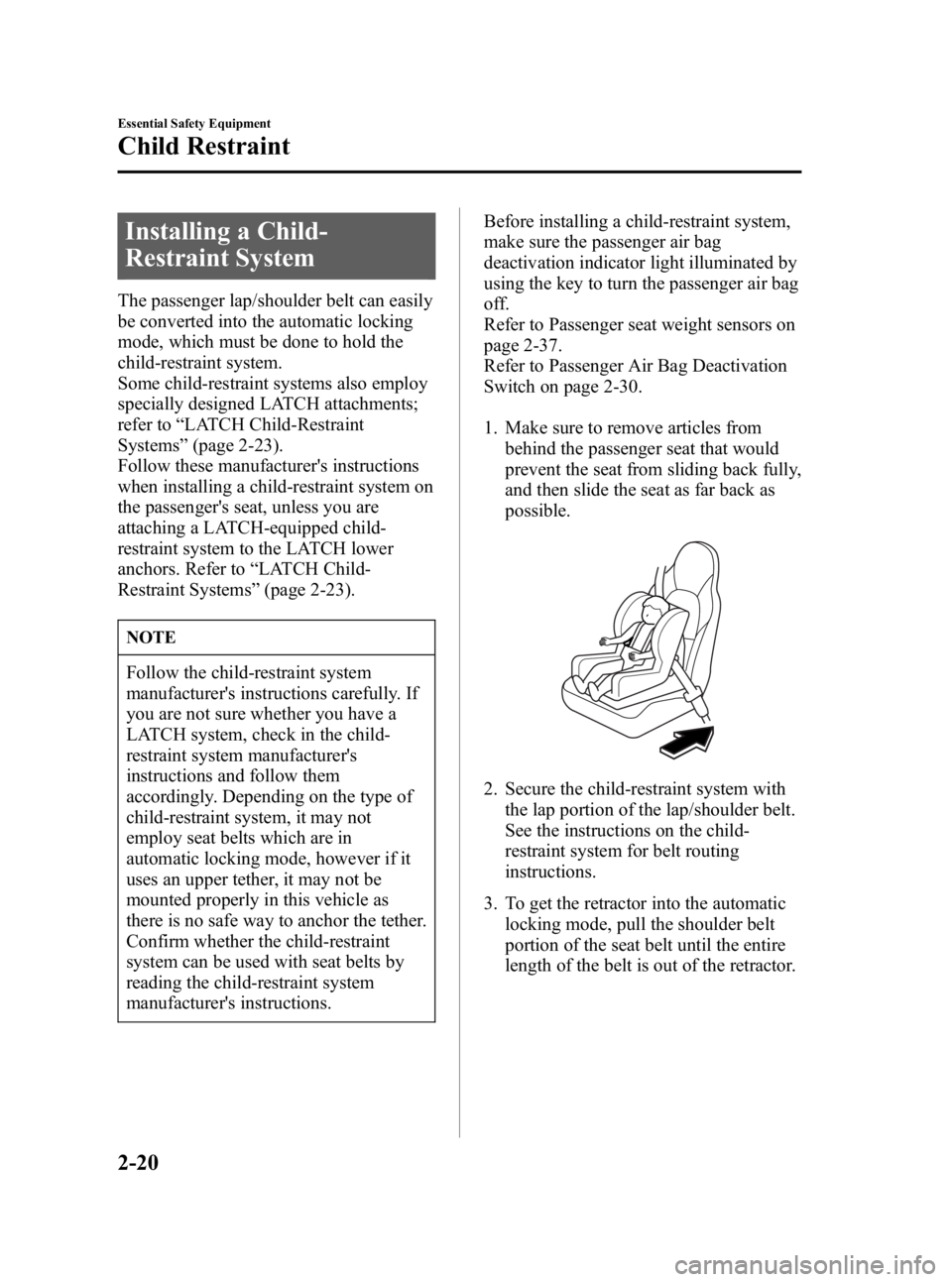
Black plate (32,1)
Installing a Child-
Restraint System
The passenger lap/shoulder belt can easily
be converted into the automatic locking
mode, which must be done to hold the
child-restraint system.
Some child-restraint systems also employ
specially designed LATCH attachments;
refer to“LATCH Child-Restraint
Systems ”(page 2-23).
Follow these manufacturer's instructions
when installing a child-restraint system on
the passenger's seat, unless you are
attaching a LATCH-equipped child-
restraint system to the LATCH lower
anchors. Refer to “LATCH Child-
Restraint Systems ”(page 2-23).
NOTE
Follow the child-restraint system
manufacturer's instructions carefully. If
you are not sure whether you have a
LATCH system, check in the child-
restraint system manufacturer's
instructions and follow them
accordingly. Depending on the type of
child-restraint system, it may not
employ seat belts which are in
automatic locking mode, however if it
uses an upper tether, it may not be
mounted properly in this vehicle as
there is no safe way to anchor the tether.
Confirm whether the child-restraint
system can be used with seat belts by
reading the child-restraint system
manufacturer's instructions. Before installing a child-restraint system,
make sure the passenger air bag
deactivation indicator light illuminated by
using the key to turn the passenger air bag
off.
Refer to Passenger seat weight sensors on
page 2-37.
Refer to Passenger Air Bag Deactivation
Switch on page 2-30.
1. Make sure to remove articles from
behind the passenger seat that would
prevent the seat from sliding back fully,
and then slide the seat as far back as
possible.
2. Secure the child-restraint system with
the lap portion of the lap/shoulder belt.
See the instructions on the child-
restraint system for belt routing
instructions.
3. To get the retractor into the automatic locking mode, pull the shoulder belt
portion of the seat belt until the entire
length of the belt is out of the retractor.
2-20
Essential Safety Equipment
Child Restraint
MX-5_8U35-EA-05F_Edition4 Page32
Thursday, October 6 2005 11:2 AM
Form No.8U35-EA-05F
Page 33 of 378
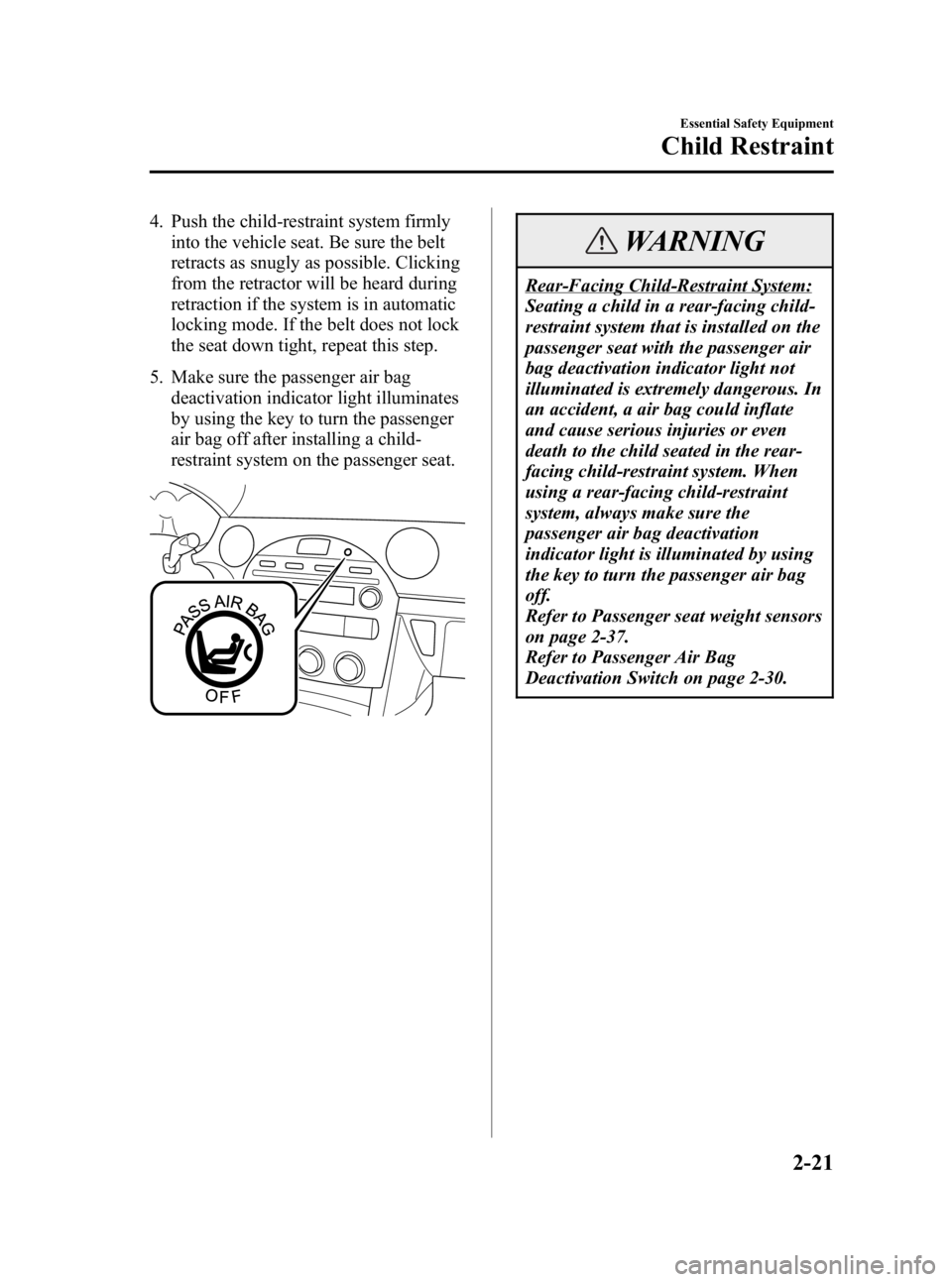
Black plate (33,1)
4. Push the child-restraint system firmlyinto the vehicle seat. Be sure the belt
retracts as snugly as possible. Clicking
from the retractor will be heard during
retraction if the system is in automatic
locking mode. If the belt does not lock
the seat down tight, repeat this step.
5. Make sure the passenger air bag deactivation indicator light illuminates
by using the key to turn the passenger
air bag off after installing a child-
restraint system on the passenger seat.
WARNING
Rear-Facing Child-Restraint System:
Seating a child in a rear-facing child-
restraint system that is installed on the
passenger seat with the passenger air
bag deactivation indicator light not
illuminated is extremely dangerous. In
an accident, a air bag could inflate
and cause serious injuries or even
death to the child seated in the rear-
facing child-restraint system. When
using a rear-facing child-restraint
system, always make sure the
passenger air bag deactivation
indicator light is illuminated by using
the key to turn the passenger air bag
off.
Refer to Passenger seat weight sensors
on page 2-37.
Refer to Passenger Air Bag
Deactivation Switch on page 2-30.
Essential Safety Equipment
Child Restraint
2-21
MX-5_8U35-EA-05F_Edition4 Page33
Thursday, October 6 2005 11:2 AM
Form No.8U35-EA-05F
Page 36 of 378
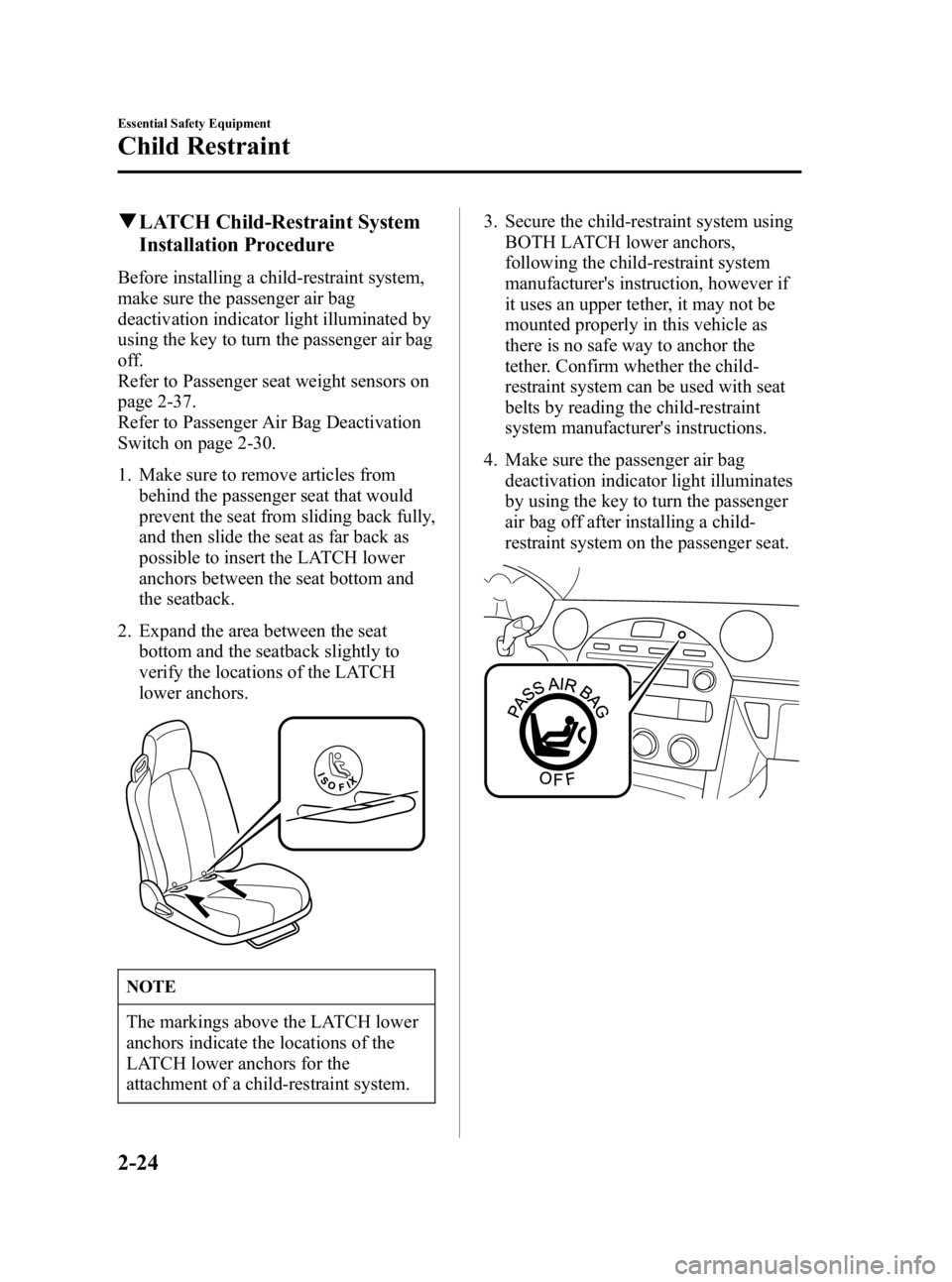
Black plate (36,1)
qLATCH Child-Restraint System
Installation Procedure
Before installing a child-restraint system,
make sure the passenger air bag
deactivation indicator light illuminated by
using the key to turn the passenger air bag
off.
Refer to Passenger seat weight sensors on
page 2-37.
Refer to Passenger Air Bag Deactivation
Switch on page 2-30.
1. Make sure to remove articles from
behind the passenger seat that would
prevent the seat from sliding back fully,
and then slide the seat as far back as
possible to insert the LATCH lower
anchors between the seat bottom and
the seatback.
2. Expand the area between the seat bottom and the seatback slightly to
verify the locations of the LATCH
lower anchors.
NOTE
The markings above the LATCH lower
anchors indicate the locations of the
LATCH lower anchors for the
attachment of a child-restraint system. 3. Secure the child-restraint system using
BOTH LATCH lower anchors,
following the child-restraint system
manufacturer's instruction, however if
it uses an upper tether, it may not be
mounted properly in this vehicle as
there is no safe way to anchor the
tether. Confirm whether the child-
restraint system can be used with seat
belts by reading the child-restraint
system manufacturer's instructions.
4. Make sure the passenger air bag deactivation indicator light illuminates
by using the key to turn the passenger
air bag off after installing a child-
restraint system on the passenger seat.
2-24
Essential Safety Equipment
Child Restraint
MX-5_8U35-EA-05F_Edition4 Page36
Thursday, October 6 2005 11:2 AM
Form No.8U35-EA-05F
Page 37 of 378
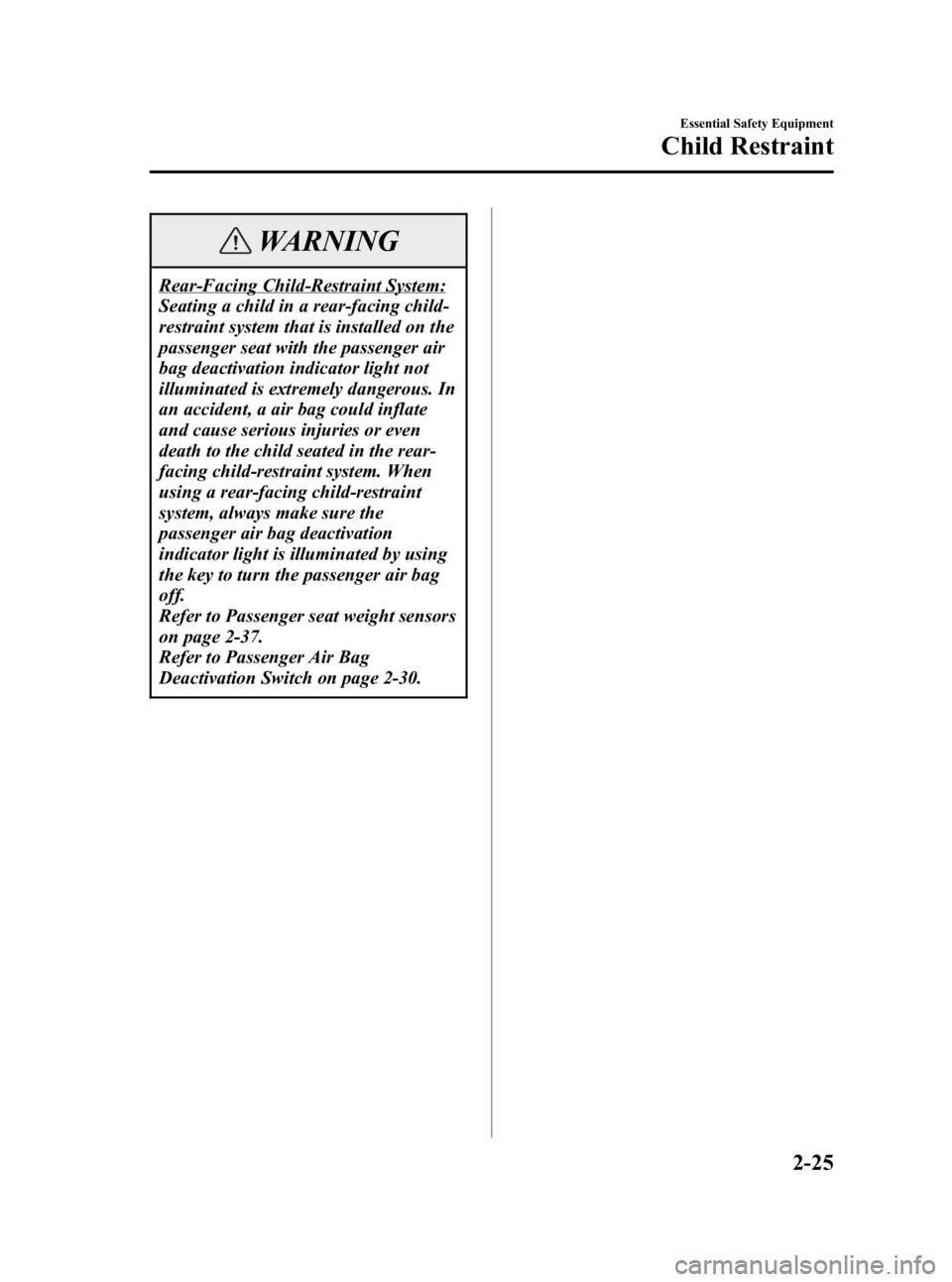
Black plate (37,1)
WARNING
Rear-Facing Child-Restraint System:
Seating a child in a rear-facing child-
restraint system that is installed on the
passenger seat with the passenger air
bag deactivation indicator light not
illuminated is extremely dangerous. In
an accident, a air bag could inflate
and cause serious injuries or even
death to the child seated in the rear-
facing child-restraint system. When
using a rear-facing child-restraint
system, always make sure the
passenger air bag deactivation
indicator light is illuminated by using
the key to turn the passenger air bag
off.
Refer to Passenger seat weight sensors
on page 2-37.
Refer to Passenger Air Bag
Deactivation Switch on page 2-30.
Essential Safety Equipment
Child Restraint
2-25
MX-5_8U35-EA-05F_Edition4 Page37
Thursday, October 6 2005 11:2 AM
Form No.8U35-EA-05F
Page 39 of 378
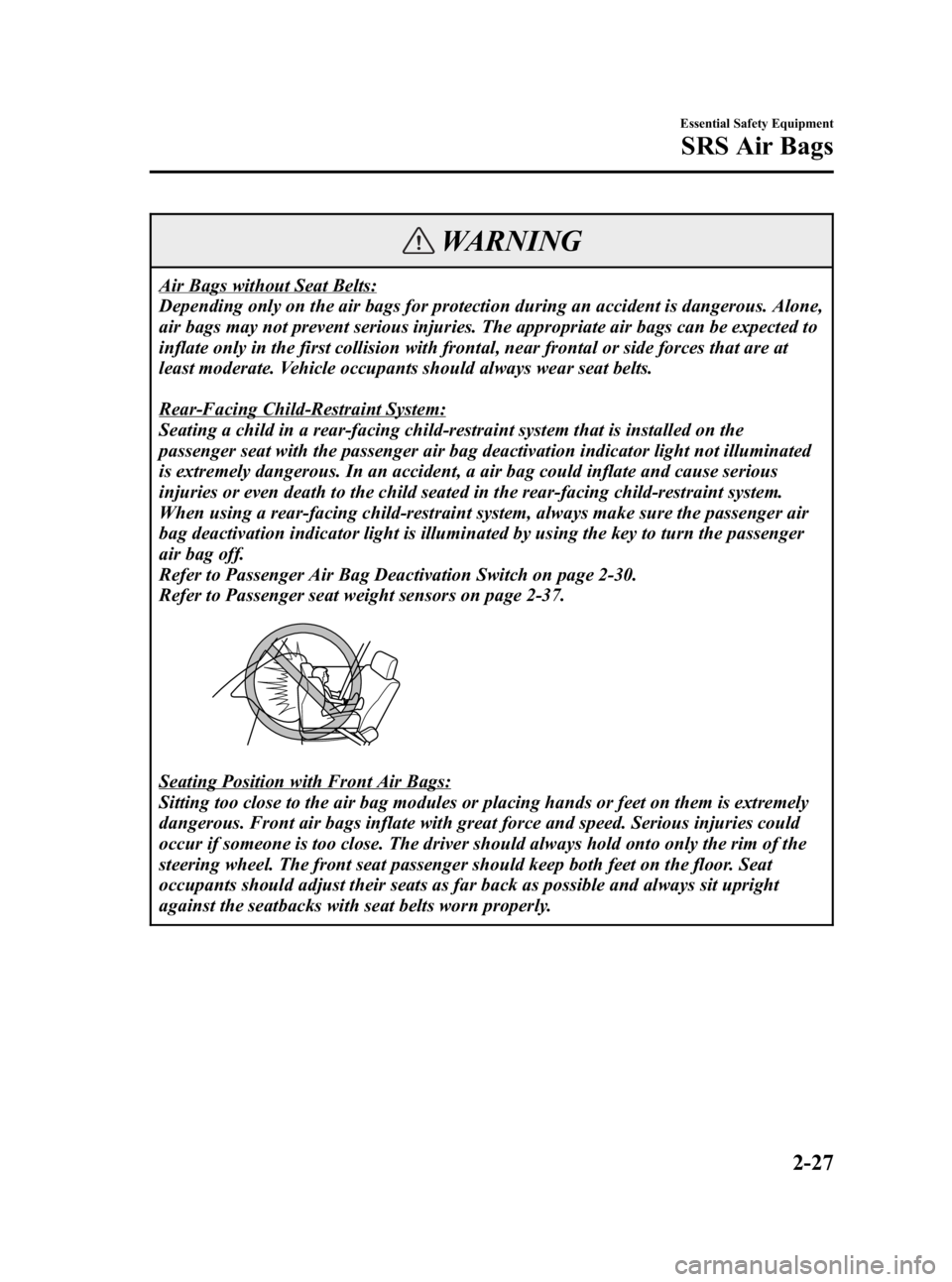
Black plate (39,1)
WARNING
Air Bags without Seat Belts:
Depending only on the air bags for protection during an accident is dangerous. Alone,
air bags may not prevent serious injuries. The appropriate air bags can be expected to
inflate only in the first collision with frontal, near frontal or side forces that are at
least moderate. Vehicle occupants should always wear seat belts.
Rear-Facing Child-Restraint System:
Seating a child in a rear-facing child-restraint system that is installed on the
passenger seat with the passenger air bag deactivation indicator light not illuminated
is extremely dangerous. In an accident, a air bag could inflate and cause serious
injuries or even death to the child seated in the rear-facing child-restraint system.
When using a rear-facing child-restraint system, always make sure the passenger air
bag deactivation indicator light is illuminated by using the key to turn the passenger
air bag off.
Refer to Passenger Air Bag Deactivation Switch on page 2-30.
Refer to Passenger seat weight sensors on page 2-37.
Seating Position with Front Air Bags:
Sitting too close to the air bag modules or placing hands or feet on them is extremely
dangerous. Front air bags inflate with great force and speed. Serious injuries could
occur if someone is too close. The driver should always hold onto only the rim of the
steering wheel. The front seat passenger should keep both feet on the floor. Seat
occupants should adjust their seats as far back as possible and always sit upright
against the seatbacks with seat belts worn properly.
Essential Safety Equipment
SRS Air Bags
2-27
MX-5_8U35-EA-05F_Edition4 Page39
Thursday, October 6 2005 11:2 AM
Form No.8U35-EA-05F
Page 44 of 378
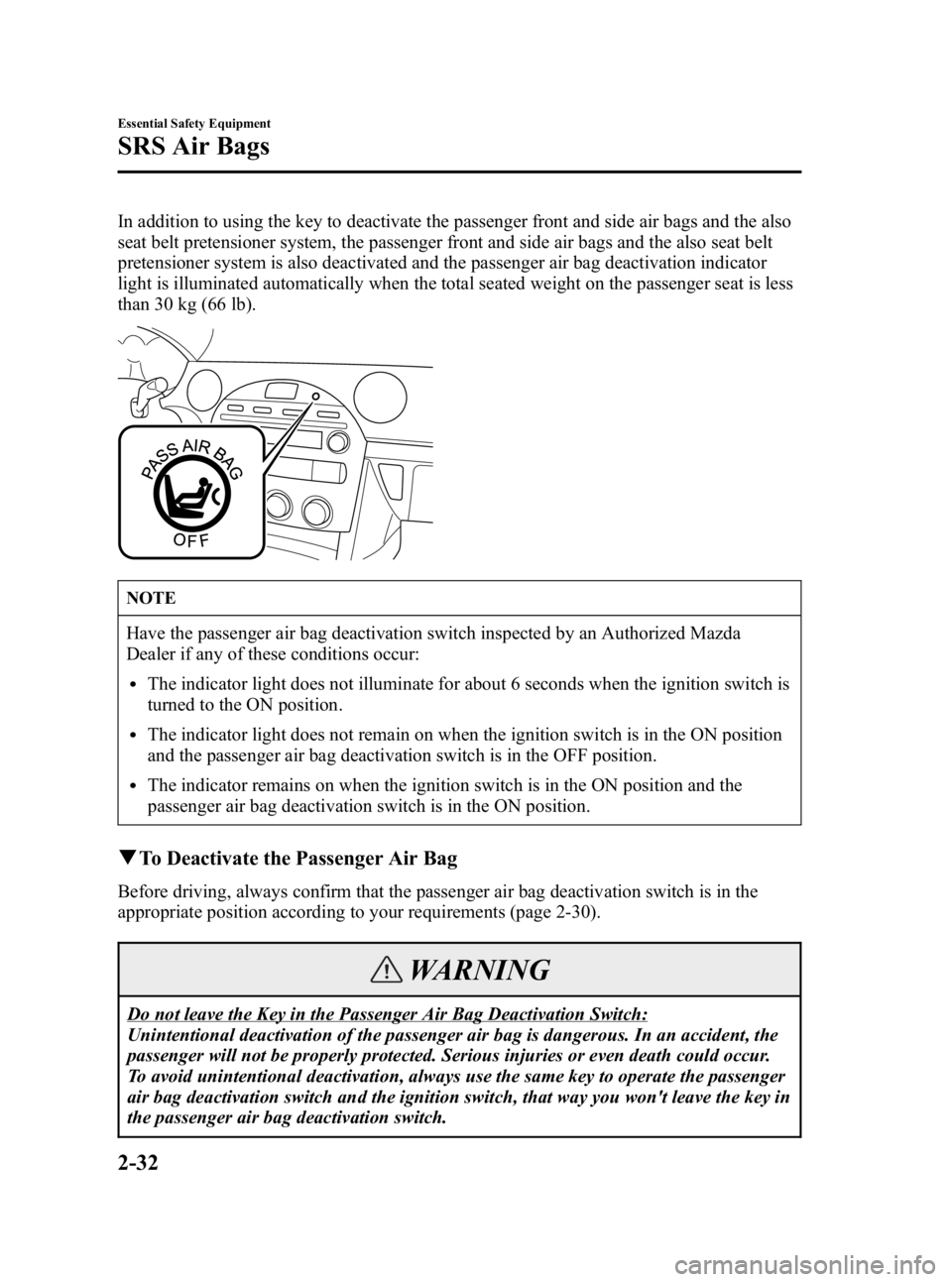
Black plate (44,1)
In addition to using the key to deactivate the passenger front and side air bags and the also
seat belt pretensioner system, the passenger front and side air bags and the also seat belt
pretensioner system is also deactivated and the passenger air bag deactivation indicator
light is illuminated automatically when the total seated weight on the passenger seat is less
than 30 kg (66 lb).
NOTE
Have the passenger air bag deactivation switch inspected by an Authorized Mazda
Dealer if any of these conditions occur:
lThe indicator light does not illuminate for about 6 seconds when the ignition switch is
turned to the ON position.
lThe indicator light does not remain on when the ignition switch is in the ON position
and the passenger air bag deactivation switch is in the OFF position.
lThe indicator remains on when the ignition switch is in the ON position and the
passenger air bag deactivation switch is in the ON position.
qTo Deactivate the Passenger Air Bag
Before driving, always confirm that the passenger air bag deactivation switch is in the
appropriate position according to your requirements (page 2-30).
WARNING
Do not leave the Key in the Passenger Air Bag Deactivation Switch:
Unintentional deactivation of the passenger air bag is dangerous. In an accident, the
passenger will not be properly protected. Serious injuries or even death could occur.
To avoid unintentional deactivation, always use the same key to operate the passenger
air bag deactivation switch and the ignition switch, that way you won't leave the key in
the passenger air bag deactivation switch.
2-32
Essential Safety Equipment
SRS Air Bags
MX-5_8U35-EA-05F_Edition4 Page44
Thursday, October 6 2005 11:2 AM
Form No.8U35-EA-05F